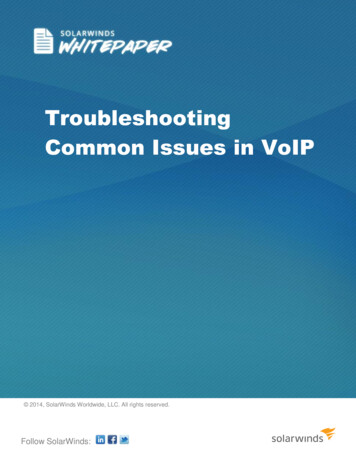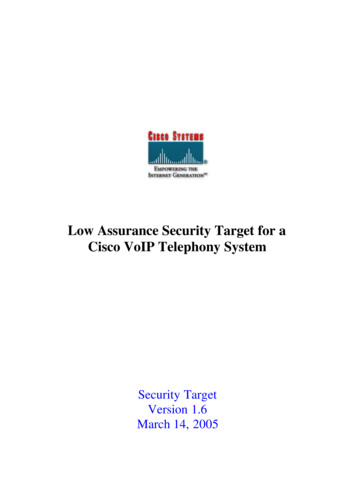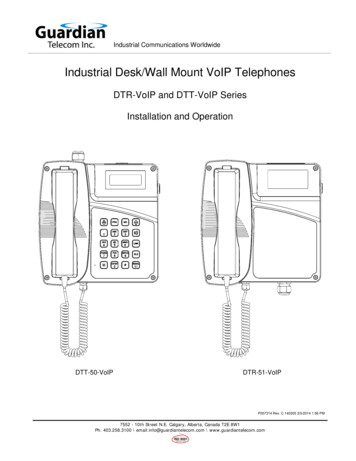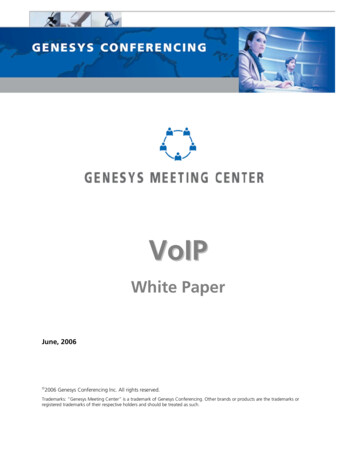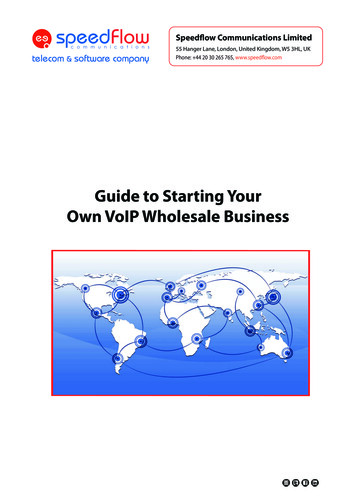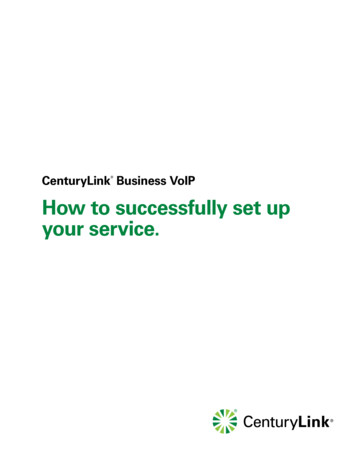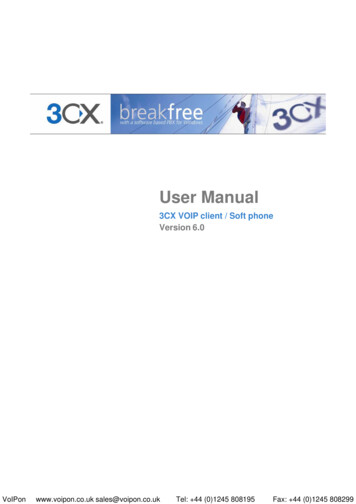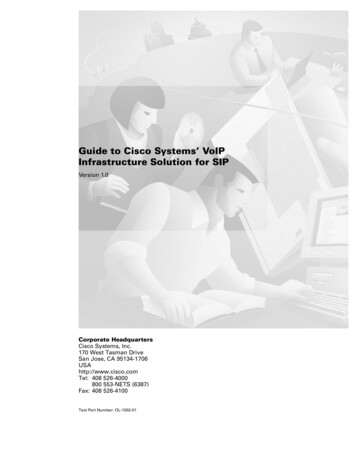
Transcription
Guide to Cisco Systems’ VoIPInfrastructure Solution for SIPVersion 1.0Corporate HeadquartersCisco Systems, Inc.170 West Tasman DriveSan Jose, CA 95134-1706USAhttp://www.cisco.comTel: 408 526-4000800 553-NETS (6387)Fax: 408 526-4100Text Part Number: OL-1002-01
THE SPECIFICATIONS AND INFORMATION REGARDING THE PRODUCTS IN THIS MANUAL ARE SUBJECT TO CHANGE WITHOUTNOTICE. ALL STATEMENTS, INFORMATION, AND RECOMMENDATIONS IN THIS MANUAL ARE BELIEVED TO BE ACCURATE BUT AREPRESENTED WITHOUT WARRANTY OF ANY KIND, EXPRESS OR IMPLIED. USERS MUST TAKE FULL RESPONSIBILITY FOR THEIRAPPLICATION OF ANY PRODUCTS.THE SOFTWARE LICENSE AND LIMITED WARRANTY FOR THE ACCOMPANYING PRODUCT ARE SET FORTH IN THE INFORMATIONPACKET THAT SHIPPED WITH THE PRODUCT AND ARE INCORPORATED HEREIN BY THIS REFERENCE. IF YOU ARE UNABLE TOLOCATE THE SOFTWARE LICENSE OR LIMITED WARRANTY, CONTACT YOUR CISCO REPRESENTATIVE FOR A COPY.The Cisco implementation of TCP header compression is an adaptation of a program developed by the University of California, Berkeley (UCB) as part ofUCB’s public domain version of the UNIX operating system. All rights reserved. Copyright 1981, Regents of the University of California.NOTWITHSTANDING ANY OTHER WARRANTY HEREIN, ALL DOCUMENT FILES AND SOFTWARE OF THESE SUPPLIERS ARE PROVIDED“AS IS” WITH ALL FAULTS. CISCO AND THE ABOVE-NAMED SUPPLIERS DISCLAIM ALL WARRANTIES, EXPRESSED OR IMPLIED,INCLUDING, WITHOUT LIMITATION, THOSE OF MERCHANTABILITY, FITNESS FOR A PARTICULAR PURPOSE ANDNONINFRINGEMENT OR ARISING FROM A COURSE OF DEALING, USAGE, OR TRADE PRACTICE.IN NO EVENT SHALL CISCO OR ITS SUPPLIERS BE LIABLE FOR ANY INDIRECT, SPECIAL, CONSEQUENTIAL, OR INCIDENTALDAMAGES, INCLUDING, WITHOUT LIMITATION, LOST PROFITS OR LOSS OR DAMAGE TO DATA ARISING OUT OF THE USE ORINABILITY TO USE THIS MANUAL, EVEN IF CISCO OR ITS SUPPLIERS HAVE BEEN ADVISED OF THE POSSIBILITY OF SUCH DAMAGES.AtmDirector, Browse with Me, CCDA, CCDE, CCDP, CCIE, CCNA, CCNP, CCSI, CD-PAC, CiscoLink, the Cisco NetWorks logo, the Cisco PoweredNetwork logo, Cisco Systems Networking Academy, the Cisco Systems Networking Academy logo, Fast Step, Follow Me Browsing, FormShare,FrameShare, GigaStack, IGX, Internet Quotient, IP/VC, iQ Breakthrough, iQ Expertise, iQ FastTrack, the iQ Logo, iQ Net Readiness Scorecard, MGX,the Networkers logo, Packet, PIX, RateMUX, ScriptBuilder, ScriptShare, SlideCast, SMARTnet, TransPath, Voice LAN, Wavelength Router, WebViewerare trademarks of Cisco Systems, Inc.; Changing the Way We Work, Live, Play, and Learn, Empowering the Internet Generation, are service marks ofCisco Systems, Inc.; and Aironet, ASIST, BPX, Catalyst, Cisco, the Cisco Certified Internetwork Expert logo,Cisco IOS, the Cisco IOS logo, Cisco Systems, Cisco Systems Capital, the Cisco Systems logo, Enterprise/Solver, EtherChannel, EtherSwitch, FastHub,FastSwitch, IOS, IP/TV, LightStream, Network Registrar, Post-Routing, Pre-Routing, Registrar, StrataView Plus, Stratm, SwitchProbe, TeleRouter, andVCO are registered trademarks of Cisco Systems, Inc. or its affiliates in the U.S. and certain other countries.All other brands, names, or trademarks mentioned in this document or Web site are the property of their respective owners. The use of the word partnerdoes not imply a partnership relationship between Cisco and any other company. (0011R)Guide to Cisco Systems’ VoIP Solution for SIPCopyright 2000, Cisco Systems, Inc.All rights reserved.
C O N T E N T SAbout this GuideObjectivesAudienceixixixOrganizationxCommand Syntax ConventionsObtaining DocumentationWorld Wide WebxxixiDocumentation CD-ROMxiOrdering DocumentationxiDocumentation FeedbackxiObtaining Technical AssistanceCisco.comxiixiiTechnical Assistance CenterxiiiContacting TAC by Using the Cisco TAC WebsiteContacting TAC by TelephoneCHAPTER11-2SIP Clients1-3SIP Servers1-3How SIP Works1-3Using A Proxy ServerUsing a Redirect ServerSIP Versus H.32321-11-1Components of SIPCHAPTERxiiiOverview of the Session Initiation ProtocolIntroduction to SIPxiii1-41-61-8Overview of the Cisco VoIP Infrastructure Solution for SIP2-1Introduction to the Cisco VoIP Infrastructure Solution for SIP2-1Illustrated Implementations2-1Intranetwork Phased Approach Implementation2-1Internetwork Phased Approach Implementation2-4Guide to Cisco Systems’ VoIP Infrastructure Solution for SIPOL-1002-01iii
ContentsProcessing Calls Within a Single SIP IP Telephony NetworkProcessing Calls Between SIP IP Telephony Networks2-62-7Processing Calls Between a SIP IP Telephony Network and a Traditional Telephony NetworkCisco VoIP Infrastructure Solution for SIP Features2-10Components of the Cisco VoIP Infrastructure Solution for SIPThe Cisco SIP IP Phone 79602-11Cisco SIP IP Phone Functional AreasThe Cisco SIP Proxy Server2-152-16Cisco SIP Proxy Server FeaturesThe Cisco uOne Messaging System2-162-172-17uOne Messaging ServeruOne Directory ServeruOne Features2-142-15Cisco SIP Gateway FeaturesuOne Gateserver2-112-11Cisco SIP IP Phone FeaturesThe Cisco SIP Gateway2-172-182-18Flexible Deployment ScenariosThe Cisco Secure PIX Firewall2-222-23Cisco Secure PIX Firewall Features2-24Cisco Secure PIX Firewall SIP Configuration GuidelinesThe Cisco SS7 Interconnect for Voice Gateways Solution2-242-24Cisco SS7 Interconnect for Voice Gateways Solution FeaturesRelated DocumentsCHAPTER32-92-252-25Installing the Cisco VoIP Infrastructure Solution for SIPEquipment Requirements3-13-1Installing the SIP Gateway3-7Installing the SIP IP Phone3-7Installing the SIP Proxy Server3-8Installing the Cisco SIP Server Linux Software3-8Installing the Cisco SIP Proxy Server Solaris SoftwareInstalling the Cisco uOne Messaging SystemInstalling the Cisco Secure PIX Firewall3-93-93-10Installing the SS7 Interconnect for Voice Gateways Solution3-10Guide to Cisco Systems’ VoIP Infrastructure Solution for SIPivOL-1002-01
ContentsCHAPTER4Configuring the Cisco VoIP Infrastructure Solution for SIPConfiguring the Routers4-14-1Configuring VoIP Support4-2Configuring the Cisco SIP GatewayConfiguring the Cisco SIP IP Phones4-24-3Configuring Startup Network ParametersConfiguring SIP Parameters4-44-4Configuring the Cisco SIP Proxy Server4-10Configuring the Cisco uOne Messaging SystemConfiguring the Cisco Secure PIX Firewall4-204-21Configuring the Cisco SS7 Interconnect for VoIP Gateways SolutionConfiguring the Signaling Controller4-22Configuring the Signaling ControllerConfiguring the Cisco SLT4-234-25Configuring the LAN Switch (Optional)4-26Configuring the Cisco AS5300 Universal Access ServerConfiguration Example4-27Example Cisco SIP IP Phone Configuration Files54-264-27Example Cisco SIP Gateway ConfigurationCHAPTER4-224-35Managing and Troubleshooting the Cisco VoIP Infrastructure Solution for SIPUsing CVM 2.0 to Manage the Cisco VoIP Infrastructure Solution for SIPPrerequisites5-15-15-2Troubleshooting the Cisco VoIP Infrastructure Solution for SIPTroubleshooting the Cisco SIP IP Phone 7960Troubleshooting FeaturesTroubleshooting Tips5-4Troubleshooting Features5-85-85-18Troubleshooting the Cisco SIP Proxy ServerTroubleshooting FeaturesTroubleshooting Tips5-35-3Troubleshooting the Cisco SIP GatewayTroubleshooting Tips5-35-215-215-22Guide to Cisco Systems’ VoIP Infrastructure Solution for SIPOL-1002-01v
ContentsCHAPTER6SIP Messages and Compliance Information for the Cisco VoIP Infrastructure Solution for SIPSIP Messages and MethodsRequestsResponses6-16-16-2The Registration ProcessThe Invitation ProcessSIP Compliance Information6-26-26-2PSTN Cause Code and SIP Event MappingsCHAPTER76-16-11SIP Call Flow Process for the Cisco VoIP Infrastructure Solution for SIPCall Flow Scenarios for Successful Calls7-17-1SIP Gateway-to-SIP Gateway—Call Setup and Disconnect7-3SIP Gateway-to-SIP Gateway—Call via SIP Redirect ServerSIP Gateway-to-SIP Gateway—Call via SIP Proxy Server7-67-9SIP Gateway-to-SIP Gateway Call—Call Setup with Delayed Media via Third-Party CallController 7-17SIP Gateway-to-SIP Gateway—Call Setup using a FQDN and Delayed MediaSIP Gateway-to- SIP Gateway Call—Redirection with CC-DiversionSIP Gateway-to-SIP Gateway Call—SIP 3xx Redirection Response7-247-28SIP Gateway-to-SIP IP Phone—Successful Call Setup and Disconnect7-32SIP Gateway-to-SIP IP Phone—Successful Call Setup and Call Hold7-34SIP Gateway-to-SIP IP Phone—Successful Call Setup and TransferSIP Gateway-to-uOne Call—Call Setup with Voice MailSIP IP Phone-to-SIP Gateway—Automatic Route Selection7-387-427-43SIP IP Phone-to-SIP Gateway—Call Setup and Call Hold with Delayed MediaSIP IP Phone-to-SIP IP Phone—Simple Call Hold7-477-50SIP IP Phone-to-SIP IP Phone—Call Hold with ConsultationSIP IP Phone-to-SIP IP Phone—Call Waiting7-207-537-57SIP IP Phone-to-SIP IP Phone—Call Transfer without ConsultationSIP IP Phone-to-SIP IP Phone—Call Transfer with Consultation7-617-63SIP IP Phone-to-SIP IP Phone—Network Call Forwarding (Unconditional)SIP IP Phone-to-SIP IP Phone—Network Call Forwarding (Busy)7-677-69Guide to Cisco Systems’ VoIP Infrastructure Solution for SIPviOL-1002-01
ContentsSIP IP Phone-to-SIP IP Phone—Network Call Forwarding (No Answer)SIP IP Phone-to-SIP IP Phone Call Forward UnconditionallySIP IP Phone-to-SIP IP Phone Call Forward on Busy7-797-84SIP IP Phone-to-SIP IP Phone Call Forward No Answer7-90SIP IP Phone-to-SIP IP Phone Call Forward Unavailable7-96Call Flow Scenarios for Failed Calls7-747-102SIP Gateway-to-SIP Gateway—Called User is Busy7-103SIP Gateway-to-SIP Gateway—Called User Does Not AnswerSIP Gateway-to SIP Gateway—Client, Server, or Global Error7-1057-107SIP Gateway-to-SIP Gateway via SIP Redirect Server—Called User is Busy7-109SIP Gateway-to-SIP Gateway via SIP Redirect Server—Called User Does Not Answer7-111SIP Gateway-to-SIP Gateway via SIP Redirect Server—Client, Server, or Global Error7-113SIP Gateway-to-SIP Gateway via SIP Proxy Server—Called User is BusySIP Gateway-to-SIP Gateway via SIP Proxy Server—Client or Server ErrorSIP Gateway-to-SIP Gateway via SIP Proxy Server—Global ErrorSIP Gateway-to-SIP IP Phone—Called User is Busy7-1227-124SIP Gateway-to-SIP IP Phone—Client, Server, or Global Error7-1267-128SIP IP Phone-to-SIP IP Phone—Call Screening Based on CallerSIP IP Phone-to-SIP IP Phone—Disallowed List7-1187-120SIP Gateway-to-SIP IP Phone—Called User Does Not AnswerSIP IP Phone-to-SIP IP Phone—Called User is Busy7-1167-1297-130SIP IP Phone-to-SIP IP Phone—Called User Does Not AnswerSIP IP Phone-to-SIP IP Phone—Authentication Error7-1317-132GLOSSARYGuide to Cisco Systems’ VoIP Infrastructure Solution for SIPOL-1002-01vii
ContentsGuide to Cisco Systems’ VoIP Infrastructure Solution for SIPviiiOL-1002-01
About this GuideThis section describes the objectives, audience, organization, and conventions of the Guide to CiscoSystems’ VoIP Infrastructure Solution for SIP.Cisco documentation and additional literature are available in a CD-ROM package, which ships withyour product. The Documentation CD-ROM, a member of the Cisco Connection Family, is updatedmonthly. Therefore, it might be more up to date than printed documentation. To order additional copiesof the Documentation CD-ROM, contact your local sales representative or call customer service. TheCD-ROM package is available as a single package or as an annual subscription. You can also accessCisco documentation on the World Wide Web at http://www.cisco.com, http://www-china.cisco.com,or http://www-europe.cisco.com.ObjectivesThis guide is designed to help you understand and implement the Cisco Voice over IP (VoIP)Infrastructure Solution for the Session Initiation Protocol (SIP), Version 1.0.AudienceThis document is intended for system administrators who will install, configure, and manage a VoIPsolution.Guide to Cisco Systems’ VoIP Infrastructure Solution for SIPOL-1002-01ix
OrganizationOrganizationThis document is divided into the following chapters:ChapterTitleDescriptionChapter 1Overview of the SessionInitiation ProtocolProvides an overview of SIP, its components, and how it works.Chapter 2Overview of the Cisco VoIPInfrastructure Solution for SIPProvides an overview of the Cisco VoIP Solution for SIP.Chapter 3Installing the Cisco VoIPInfrastructure Solution for SIPProvides an overview of how to install the components of the Cisco VoIPSolution for SIP.Chapter 4Configuring the Cisco VoIPInfrastructure Solution for SIPProvides scenario-based examples of how to configure the componentsof the Cisco VoIP Solution for SIP.Chapter 5Managing and Troubleshootingthe Cisco VoIP InfrastructureSolution for SIPDescribes the tools that are available for managing and troubleshootingthe Cisco VoIP Solution for SIP. This chapter also provides tips forproblem isolation and recommendations for problem resolution.Chapter 6SIP Messages and ComplianceInformation for the Cisco VoIPInfrastructure Solution for SIPDescribes the methods and messages used by SIP and how thecomponents of the solution handles these methods and messages.Chapter 7SIP Call Flow Process for theCisco VoIP InfrastructureSolution for SIPIllustrates how SIP messages are exchanged during the call process.GlossaryProvides definitions of the acronyms and terms used in this document.Command Syntax ConventionsTable 1 describes the syntax used with the commands in this document.Table 1Command Syntax GuideConventionDescriptionboldfaceCommands and keywords.italicCommand input that is supplied by you.[Keywords or arguments that appear within square brackets are optional.]{x x x}A choice of keywords (represented by x) appears in braces separated byvertical bars. You must select one. or CtrlRepresent the key labeled Control. For example, when you read D orCtrl-D, you should hold down the Control key while you press the D key.screen fontExamples of information displayed on the screen.boldface screen fontExamples of information that you must enter. Nonprinting characters, such as passwords, appear in angled brackets.[]Default responses to system prompts appear in square brackets.Guide to Cisco Systems’ VoIP Infrastructure Solution for SIPxOL-1002-01
Obtaining DocumentationObtaining DocumentationThe following sections provide sources for obtaining documentation from Cisco Systems.World Wide WebYou can access the most current Cisco documentation on the World Wide Web at the following sites: http://www.cisco.com http://www-china.cisco.com http://www-europe.cisco.comDocumentation CD-ROMCisco documentation and additional literature are available in a CD-ROM package, which shipswith your product. The Documentation CD-ROM is updated monthly and may be more current thanprinted documentation. The CD-ROM package is available as a single unit or as an annual subscription.Ordering DocumentationCisco documentation is available in the following ways: Registered Cisco Direct Customers can order Cisco Product documentation from the NetworkingProducts er root.pl Registered Cisco.com users can order the Documentation CD-ROM through the onlineSubscription Store:http://www.cisco.com/go/subscription Nonregistered Cisco.com users can order documentation through a local account representative bycalling Cisco corporate headquarters (California, USA) at 408 526-7208 or, in North America, bycalling 800 553-NETS(6387).Documentation FeedbackIf you are reading Cisco product documentation on the World Wide Web, you can submit technicalcomments electronically. Click Feedback in the toolbar and select Documentation. After you completethe form, click Submit to send it to Cisco.You can e-mail your comments to bug-doc@cisco.com.Guide to Cisco Systems’ VoIP Infrastructure Solution for SIPOL-1002-01xi
Obtaining Technical AssistanceTo submit your comments by mail, use the response card behind the front cover of your document, orwrite to the following address:Attn Document Resource ConnectionCisco Systems, Inc.170 West Tasman DriveSan Jose, CA 95134-9883We appreciate your comments.Obtaining Technical AssistanceCisco provides Cisco.com as a starting point for all technical assistance. Customers and partners canobtain documentation, troubleshooting tips, and sample configurations from online tools. ForCisco.com registered users, additional troubleshooting tools are available from the TAC website.Cisco.comCisco.com is the foundation of a suite of interactive, networked services that provides immediate, openaccess to Cisco information and resources at anytime, from anywhere in the world. This highlyintegrated Internet application is a powerful, easy-to-use tool for doing business with Cisco.Cisco.com provides a broad range of features and services to help customers and partners streamlinebusiness processes and improve productivity. Through Cisco.com, you can find information about Ciscoand our networking solutions, services, and programs. In addition, you can resolve technical issues withonline technical support, download and test software packages, and order Cisco learning materials andmerchandise. Valuable online skill assessment, training, and certification programs are also available.Customers and partners can self-register on Cisco.com to obtain additional personalized informationand services. Registered users can order products, check on the status of an order, access technicalsupport, and view benefits specific to their relationships with Cisco.To access Cisco.com, go to the following website:http://www.cisco.comGuide to Cisco Systems’ VoIP Infrastructure Solution for SIPxiiOL-1002-01
Obtaining Technical AssistanceTechnical Assistance CenterThe Cisco TAC website is available to all customers who need technical assistance with a Cisco productor technology that is under warranty or covered by a maintenance contract.Contacting TAC by Using the Cisco TAC WebsiteIf you have a priority level 3 (P3) or priority level 4 (P4) problem, contact TAC by going to the TACwebsite:http://www.cisco.com/tacP3 and P4 level problems are defined as follows: P3—Your network performance is degraded. Network functionality is noticeably impaired, butmost business operations continue. P4—You need information or assistance on Cisco product capabilities, product installation, or basicproduct configuration.In each of the above cases, use the Cisco TAC website to quickly find answers to your questions.To register for Cisco.com, go to the following website:http://www.cisco.com/register/If you cannot resolve your technical issue by using the TAC online resources, Cisco.com registeredusers can open a case online by using the TAC Case Open tool at the following g TAC by TelephoneIf you have a priority level 1(P1) or priority level 2 (P2) problem, contact TAC by telephone andimmediately open a case. To obtain a directory of toll-free numbers for your country, go to the 687/Directory/DirTAC.shtmlP1 and P2 level problems are defined as follows: P1—Your production network is down, causing a critical impact to business operations if serviceis not restored quickly. No workaround is available. P2—Your production network is severely degraded, affecting significant aspects of your businessoperations. No workaround is available.Guide to Cisco Systems’ VoIP Infrastructure Solution for SIPOL-1002-01xiii
Obtaining Technical AssistanceGuide to Cisco Systems’ VoIP Infrastructure Solution for SIPxivOL-1002-01
C H A P T E R1Overview of the Session Initiation ProtocolThis chapter provides an overview of SIP. It includes the following sections: Introduction to SIP, page 1-1 Components of SIP, page 1-2 How SIP Works, page 1-3 SIP Versus H.323, page 1-8Introduction to SIPSession Initiation Protocol (SIP) is the Internet Engineering Task Force’s (IETF’s) standard formultimedia conferencing over IP. SIP is an ASCII-based, application-layer control protocol (defined inRFC 2543) that can be used to establish, maintain, and terminate calls between two or more end points.Like other VoIP protocols, SIP is designed to address the func
The Cisco uOne Messaging System 2-17 uOne Gateserver 2-17 uOne Messaging Server 2-17 uOne Directory Server 2-18 uOne Features 2-18 Flexible Deployment Scenarios 2-22 The Cisco Secure PIX Firewall 2-23 Cisco Secure PIX Firewall Features 2-24 Cisco Secure PIX Firewall SIP Configuration Guidelin

